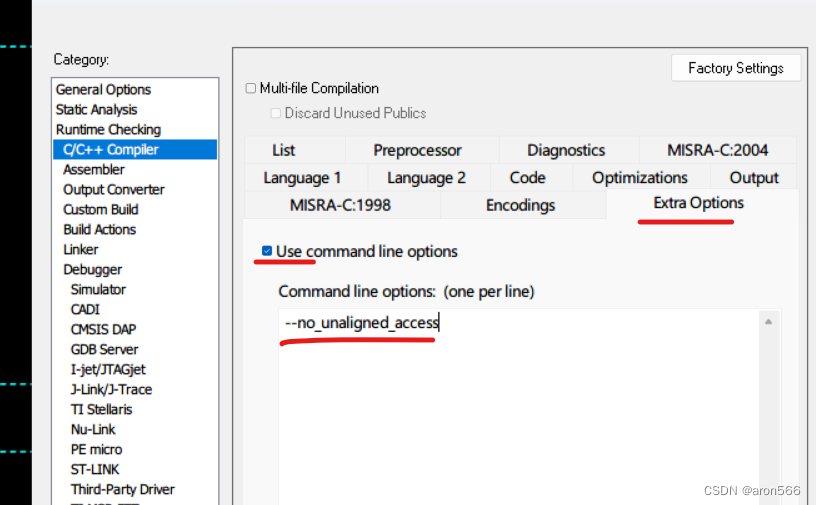环境
硬件
- MCU:STM32H743VIT6
- LCD:SPI接口驱动
- TP:触摸I2C驱动
前提准备
下载图形库代码
下载地址:点我
图形库的使用教程说明:https://docs.lvgl.io/master/index.html
图形开发中的字体转换、图片转换
地址:https://lvgl.io/tools/fontconverter

本地转换工具:simhei.ttf字体文件可以去windows目录查找使用
# 安装Node.js
https://nodejs.org/en/download/
# 执行安装命令
npm i lv_font_conv -g
# 测试可用
npx lv_font_conv -h
# 使用
lv_font_conv --no-compress --format lvgl --font simhei.ttf -o xx_font_21.c --bpp 4 --size 30 --symbols 设备维护固件升级,请勿关机
GUI-GUIDER 图形化开发lvgl
GUI-GUIDER下载地址
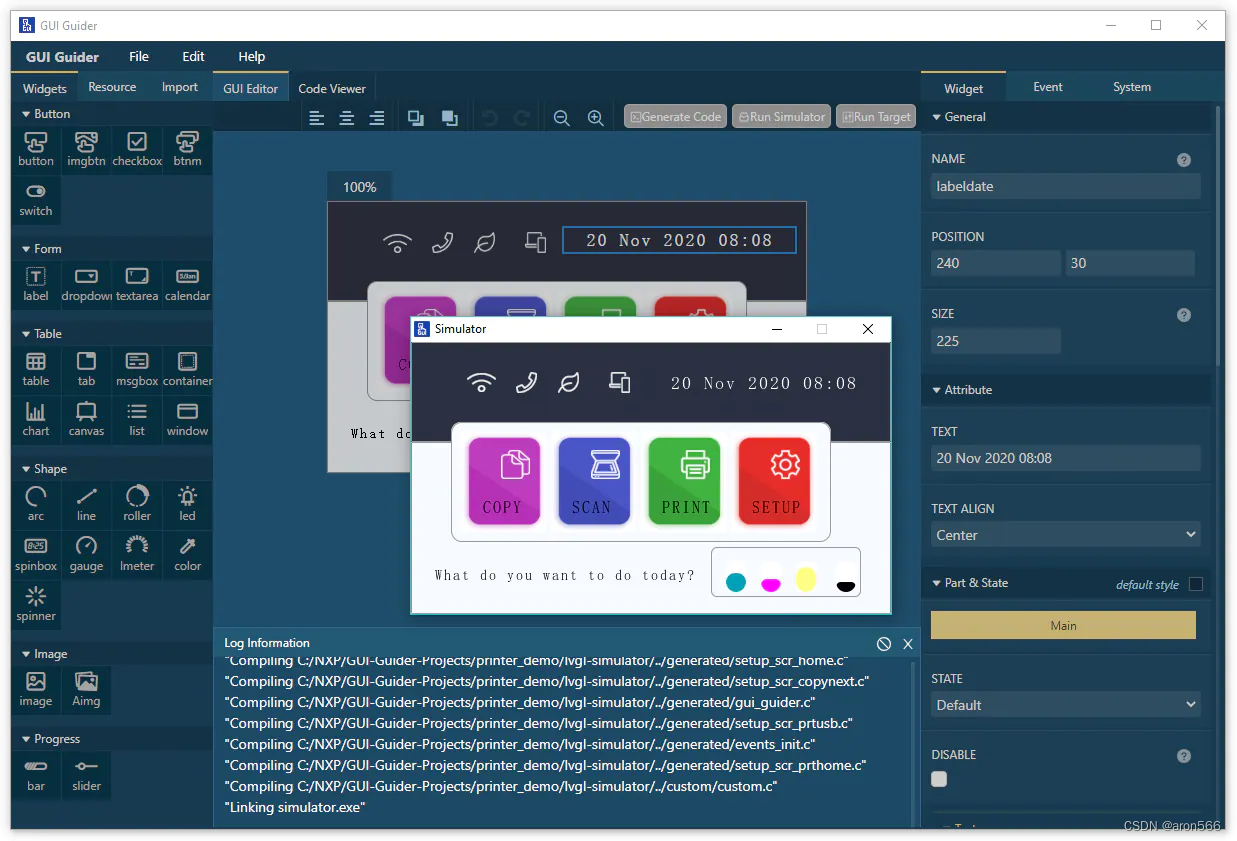
正常安装后,通常新建一个工程,导入我们想要的字体文件(*.ttf),进行之后的开发,之后生成代码,导入生成的c文件到工程项目中。具体使用方法:地址
移植
加入相关源代码到工程中
对下载的lvglv8.2源码解压后得到目录:
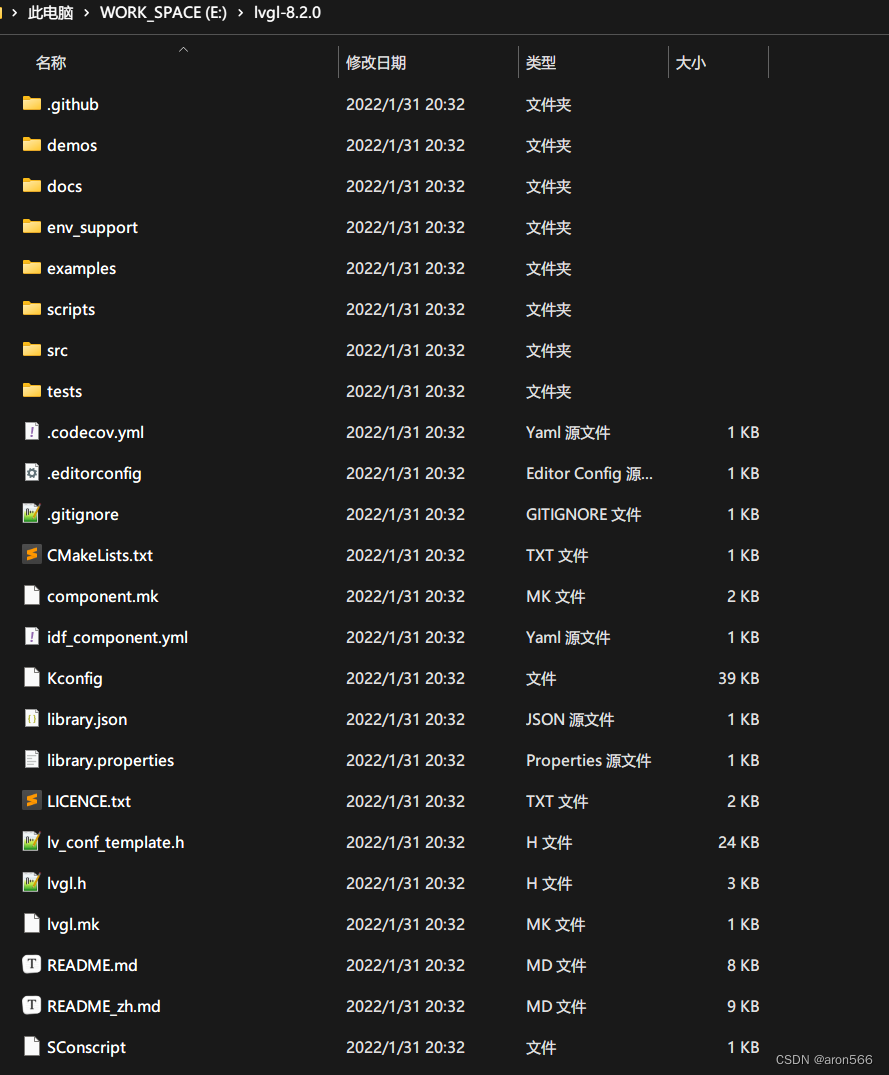
1、删除无效文件夹及文件:
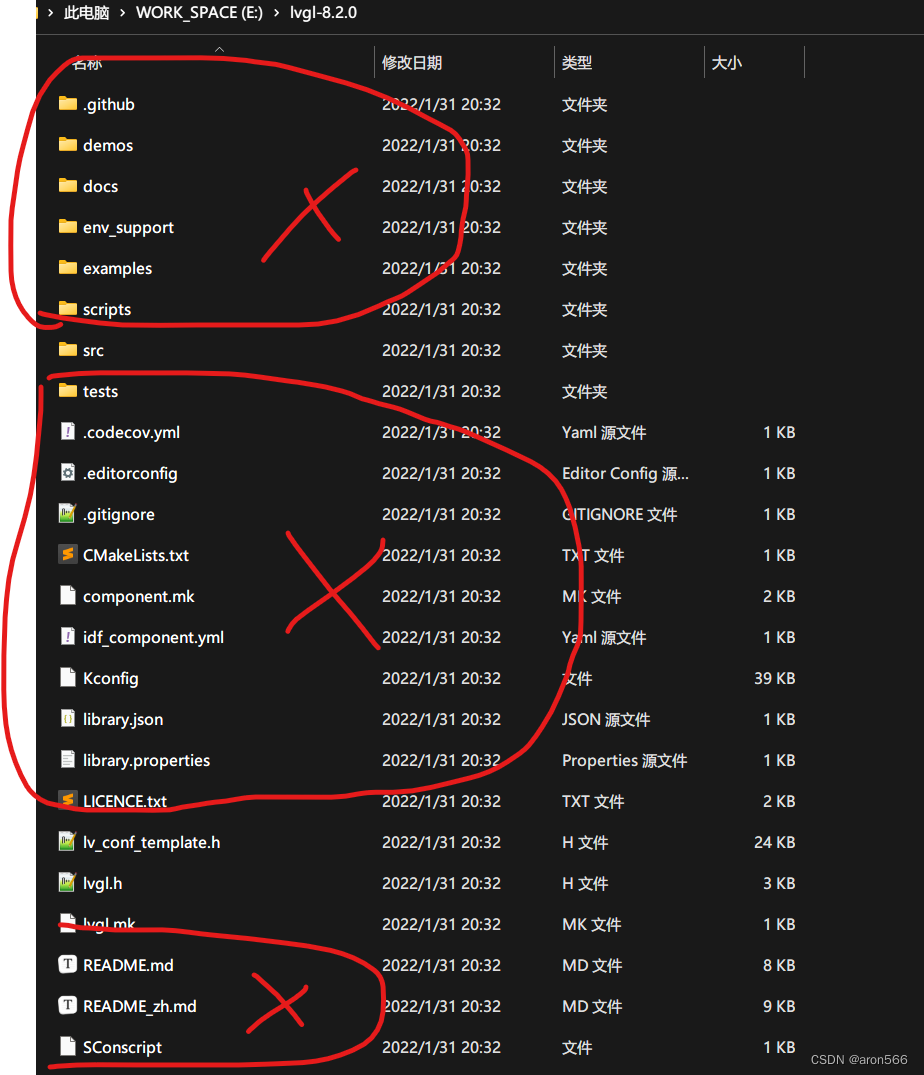
添加相关文件目录:port(图形硬件驱动接口、触摸接口) 、 gui(放置GUI-GUIDER 生成的代码)

2、添加文件到工程:
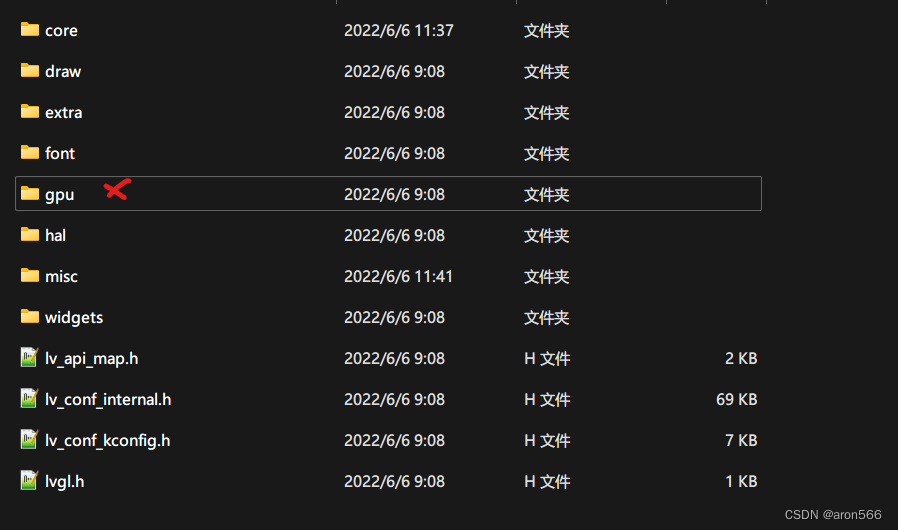
添加到IAR中:这里不要在意添加了许多字体文件,可以通过配置lv_conf.h不加入编译

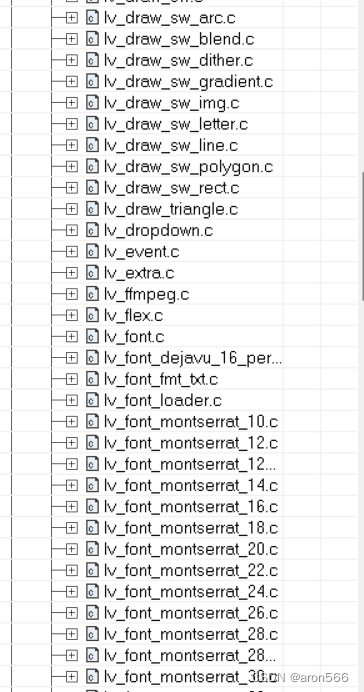
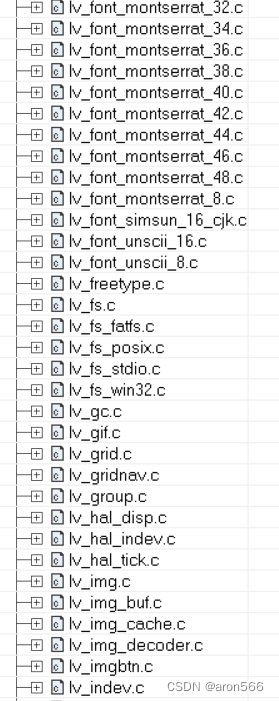

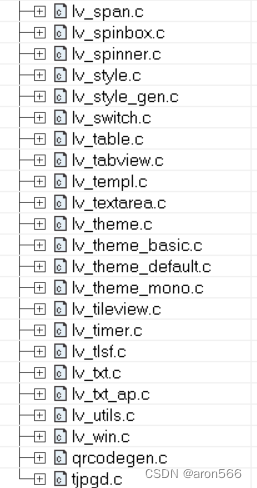
3、配置lvgl lv_conf.h
/**
* @file lv_conf.h
* Configuration file for v8.2.0
*/
/*
* Copy this file as `lv_conf.h`
* 1. simply next to the `lvgl` folder
* 2. or any other places and
* - define `LV_CONF_INCLUDE_SIMPLE`
* - add the path as include path
*/
/* clang-format off */
#if 1 /*Set it to "1" to enable content*/
#ifndef LV_CONF_H
#define LV_CONF_H
#include <stdint.h>
/*====================
COLOR SETTINGS
*====================*/
/*Color depth: 1 (1 byte per pixel), 8 (RGB332), 16 (RGB565), 32 (ARGB8888)*/
#define LV_COLOR_DEPTH 16
/*Swap the 2 bytes of RGB565 color. Useful if the display has an 8-bit interface (e.g. SPI)*/
#define LV_COLOR_16_SWAP 0
/*Enable more complex drawing routines to manage screens transparency.
*Can be used if the UI is above another layer, e.g. an OSD menu or video player.
*Requires `LV_COLOR_DEPTH = 32` colors and the screen's `bg_opa` should be set to non LV_OPA_COVER value*/
#define LV_COLOR_SCREEN_TRANSP 0
/* Adjust color mix functions rounding. GPUs might calculate color mix (blending) differently.
* 0: round down, 64: round up from x.75, 128: round up from half, 192: round up from x.25, 254: round up */
#define LV_COLOR_MIX_ROUND_OFS (LV_COLOR_DEPTH == 32 ? 0: 128)
/*Images pixels with this color will not be drawn if they are chroma keyed)*/
#define LV_COLOR_CHROMA_KEY lv_color_hex(0x00ff00) /*pure green*/
/*=========================
MEMORY SETTINGS
*=========================*/
/*1: use custom malloc/free, 0: use the built-in `lv_mem_alloc()` and `lv_mem_free()`*/
#define LV_MEM_CUSTOM 0
#if LV_MEM_CUSTOM == 0
/*Size of the memory available for `lv_mem_alloc()` in bytes (>= 2kB)*/
#define LV_MEM_SIZE (16U * 1024U) /*[bytes]*/
/*Set an address for the memory pool instead of allocating it as a normal array. Can be in external SRAM too.*/
#define LV_MEM_ADR 0 /*0: unused*/
/*Instead of an address give a memory allocator that will be called to get a memory pool for LVGL. E.g. my_malloc*/
#if LV_MEM_ADR == 0
//#define LV_MEM_POOL_INCLUDE your_alloc_library /* Uncomment if using an external allocator*/
//#define LV_MEM_POOL_ALLOC your_alloc /* Uncomment if using an external allocator*/
#endif
#else /*LV_MEM_CUSTOM*/
#define LV_MEM_CUSTOM_INCLUDE <stdlib.h> /*Header for the dynamic memory function*/
#define LV_MEM_CUSTOM_ALLOC malloc
#define LV_MEM_CUSTOM_FREE free
#define LV_MEM_CUSTOM_REALLOC realloc
#endif /*LV_MEM_CUSTOM*/
/*Number of the intermediate memory buffer used during rendering and other internal processing mechanisms.
*You will see an error log message if there wasn't enough buffers. */
#define LV_MEM_BUF_MAX_NUM 16
/*Use the standard `memcpy` and `memset` instead of LVGL's own functions. (Might or might not be faster).*/
#define LV_MEMCPY_MEMSET_STD 0
/*====================
HAL SETTINGS
*====================*/
/*Default display refresh period. LVG will redraw changed areas with this period time*/
#define LV_DISP_DEF_REFR_PERIOD 30 /*[ms]*/
/*Input device read period in milliseconds*/
#define LV_INDEV_DEF_READ_PERIOD 30 /*[ms]*/
/*Use a custom tick source that tells the elapsed time in milliseconds.
*It removes the need to manually update the tick with `lv_tick_inc()`)*/
#define LV_TICK_CUSTOM 0
#if LV_TICK_CUSTOM
#define LV_TICK_CUSTOM_INCLUDE "Arduino.h" /*Header for the system time function*/
#define LV_TICK_CUSTOM_SYS_TIME_EXPR (millis()) /*Expression evaluating to current system time in ms*/
#endif /*LV_TICK_CUSTOM*/
/*Default Dot Per Inch. Used to initialize default sizes such as widgets sized, style paddings.
*(Not so important, you can adjust it to modify default sizes and spaces)*/
#define LV_DPI_DEF 60 /*[px/inch]*/
/*=======================
* FEATURE CONFIGURATION
*=======================*/
/*-------------
* Drawing
*-----------*/
/*Enable complex draw engine.
*Required to draw shadow, gradient, rounded corners, circles, arc, skew lines, image transformations or any masks*/
#define LV_DRAW_COMPLEX 1
#if LV_DRAW_COMPLEX != 0
/*Allow buffering some shadow calculation.
*LV_SHADOW_CACHE_SIZE is the max. shadow size to buffer, where shadow size is `shadow_width + radius`
*Caching has LV_SHADOW_CACHE_SIZE^2 RAM cost*/
#define LV_SHADOW_CACHE_SIZE 0
/* Set number of maximally cached circle data.
* The circumference of 1/4 circle are saved for anti-aliasing
* radius * 4 bytes are used per circle (the most often used radiuses are saved)
* 0: to disable caching */
#define LV_CIRCLE_CACHE_SIZE 4
#endif /*LV_DRAW_COMPLEX*/
/*Default image cache size. Image caching keeps the images opened.
*If only the built-in image formats are used there is no real advantage of caching. (I.e. if no new image decoder is added)
*With complex image decoders (e.g. PNG or JPG) caching can save the continuous open/decode of images.
*However the opened images might consume additional RAM.
*0: to disable caching*/
#define LV_IMG_CACHE_DEF_SIZE 0
/*Number of stops allowed per gradient. Increase this to allow more stops.
*This adds (sizeof(lv_color_t) + 1) bytes per additional stop*/
#define LV_GRADIENT_MAX_STOPS 2
/*Default gradient buffer size.
*When LVGL calculates the gradient "maps" it can save them into a cache to avoid calculating them again.
*LV_GRAD_CACHE_DEF_SIZE sets the size of this cache in bytes.
*If the cache is too small the map will be allocated only while it's required for the drawing.
*0 mean no caching.*/
#define LV_GRAD_CACHE_DEF_SIZE 0
/*Allow dithering the gradients (to achieve visual smooth color gradients on limited color depth display)
*LV_DITHER_GRADIENT implies allocating one or two more lines of the object's rendering surface
*The increase in memory consumption is (32 bits * object width) plus 24 bits * object width if using error diffusion */
#define LV_DITHER_GRADIENT 0
#if LV_DITHER_GRADIENT
/*Add support for error diffusion dithering.
*Error diffusion dithering gets a much better visual result, but implies more CPU consumption and memory when drawing.
*The increase in memory consumption is (24 bits * object's width)*/
#define LV_DITHER_ERROR_DIFFUSION 0
#endif
/*Maximum buffer size to allocate for rotation.
*Only used if software rotation is enabled in the display driver.*/
#define LV_DISP_ROT_MAX_BUF (10*1024)
/*-------------
* GPU
*-----------*/
/*Use STM32's DMA2D (aka Chrom Art) GPU*/
#define LV_USE_GPU_STM32_DMA2D 0
#if LV_USE_GPU_STM32_DMA2D
/*Must be defined to include path of CMSIS header of target processor
e.g. "stm32f769xx.h" or "stm32f429xx.h"*/
#define LV_GPU_DMA2D_CMSIS_INCLUDE
#endif
/*Use NXP's PXP GPU iMX RTxxx platforms*/
#define LV_USE_GPU_NXP_PXP 0
#if LV_USE_GPU_NXP_PXP
/*1: Add default bare metal and FreeRTOS interrupt handling routines for PXP (lv_gpu_nxp_pxp_osa.c)
* and call lv_gpu_nxp_pxp_init() automatically during lv_init(). Note that symbol SDK_OS_FREE_RTOS
* has to be defined in order to use FreeRTOS OSA, otherwise bare-metal implementation is selected.
*0: lv_gpu_nxp_pxp_init() has to be called manually before lv_init()
*/
#define LV_USE_GPU_NXP_PXP_AUTO_INIT 0
#endif
/*Use NXP's VG-Lite GPU iMX RTxxx platforms*/
#define LV_USE_GPU_NXP_VG_LITE 0
/*Use SDL renderer API*/
#define LV_USE_GPU_SDL 0
#if LV_USE_GPU_SDL
#define LV_GPU_SDL_INCLUDE_PATH <SDL2/SDL.h>
/*Texture cache size, 8MB by default*/
#define LV_GPU_SDL_LRU_SIZE (1024 * 1024 * 8)
/*Custom blend mode for mask drawing, disable if you need to link with older SDL2 lib*/
#define LV_GPU_SDL_CUSTOM_BLEND_MODE (SDL_VERSION_ATLEAST(2, 0, 6))
#endif
/*-------------
* Logging
*-----------*/
/*Enable the log module*/
#define LV_USE_LOG 0
#if LV_USE_LOG
/*How important log should be added:
*LV_LOG_LEVEL_TRACE A lot of logs to give detailed information
*LV_LOG_LEVEL_INFO Log important events
*LV_LOG_LEVEL_WARN Log if something unwanted happened but didn't cause a problem
*LV_LOG_LEVEL_ERROR Only critical issue, when the system may fail
*LV_LOG_LEVEL_USER Only logs added by the user
*LV_LOG_LEVEL_NONE Do not log anything*/
#define LV_LOG_LEVEL LV_LOG_LEVEL_WARN
/*1: Print the log with 'printf';
*0: User need to register a callback with `lv_log_register_print_cb()`*/
#define LV_LOG_PRINTF 0
/*Enable/disable LV_LOG_TRACE in modules that produces a huge number of logs*/
#define LV_LOG_TRACE_MEM 1
#define LV_LOG_TRACE_TIMER 1
#define LV_LOG_TRACE_INDEV 1
#define LV_LOG_TRACE_DISP_REFR 1
#define LV_LOG_TRACE_EVENT 1
#define LV_LOG_TRACE_OBJ_CREATE 1
#define LV_LOG_TRACE_LAYOUT 1
#define LV_LOG_TRACE_ANIM 1
#endif /*LV_USE_LOG*/
/*-------------
* Asserts
*-----------*/
/*Enable asserts if an operation is failed or an invalid data is found.
*If LV_USE_LOG is enabled an error message will be printed on failure*/
#define LV_USE_ASSERT_NULL 1 /*Check if the parameter is NULL. (Very fast, recommended)*/
#define LV_USE_ASSERT_MALLOC 1 /*Checks is the memory is successfully allocated or no. (Very fast, recommended)*/
#define LV_USE_ASSERT_STYLE 0 /*Check if the styles are properly initialized. (Very fast, recommended)*/
#define LV_USE_ASSERT_MEM_INTEGRITY 0 /*Check the integrity of `lv_mem` after critical operations. (Slow)*/
#define LV_USE_ASSERT_OBJ 0 /*Check the object's type and existence (e.g. not deleted). (Slow)*/
/*Add a custom handler when assert happens e.g. to restart the MCU*/
#define LV_ASSERT_HANDLER_INCLUDE <stdint.h>
#define LV_ASSERT_HANDLER while(1); /*Halt by default*/
/*-------------
* Others
*-----------*/
/*1: Show CPU usage and FPS count*/
#define LV_USE_PERF_MONITOR 0
#if LV_USE_PERF_MONITOR
#define LV_USE_PERF_MONITOR_POS LV_ALIGN_BOTTOM_RIGHT
#endif
/*1: Show the used memory and the memory fragmentation
* Requires LV_MEM_CUSTOM = 0*/
#define LV_USE_MEM_MONITOR 0
#if LV_USE_MEM_MONITOR
#define LV_USE_MEM_MONITOR_POS LV_ALIGN_BOTTOM_LEFT
#endif
/*1: Draw random colored rectangles over the redrawn areas*/
#define LV_USE_REFR_DEBUG 0
/*Change the built in (v)snprintf functions*/
#define LV_SPRINTF_CUSTOM 0
#if LV_SPRINTF_CUSTOM
#define LV_SPRINTF_INCLUDE <stdio.h>
#define lv_snprintf snprintf
#define lv_vsnprintf vsnprintf
#else /*LV_SPRINTF_CUSTOM*/
#define LV_SPRINTF_USE_FLOAT 0
#endif /*LV_SPRINTF_CUSTOM*/
#define LV_USE_USER_DATA 1
/*Garbage Collector settings
*Used if lvgl is bound to higher level language and the memory is managed by that language*/
#define LV_ENABLE_GC 0
#if LV_ENABLE_GC != 0
#define LV_GC_INCLUDE "gc.h" /*Include Garbage Collector related things*/
#endif /*LV_ENABLE_GC*/
/*=====================
* COMPILER SETTINGS
*====================*/
/*For big endian systems set to 1*/
#define LV_BIG_ENDIAN_SYSTEM 0
/*Define a custom attribute to `lv_tick_inc` function*/
#define LV_ATTRIBUTE_TICK_INC
/*Define a custom attribute to `lv_timer_handler` function*/
#define LV_ATTRIBUTE_TIMER_HANDLER
/*Define a custom attribute to `lv_disp_flush_ready` function*/
#define LV_ATTRIBUTE_FLUSH_READY
/*Required alignment size for buffers*/
#define LV_ATTRIBUTE_MEM_ALIGN_SIZE 1
/*Will be added where memories needs to be aligned (with -Os data might not be aligned to boundary by default).
* E.g. __attribute__((aligned(4)))*/
#define LV_ATTRIBUTE_MEM_ALIGN
/*Attribute to mark large constant arrays for example font's bitmaps*/
#define LV_ATTRIBUTE_LARGE_CONST
/*Compiler prefix for a big array declaration in RAM*/
#define LV_ATTRIBUTE_LARGE_RAM_ARRAY
/*Place performance critical functions into a faster memory (e.g RAM)*/
#define LV_ATTRIBUTE_FAST_MEM
/*Prefix variables that are used in GPU accelerated operations, often these need to be placed in RAM sections that are DMA accessible*/
#define LV_ATTRIBUTE_DMA
/*Export integer constant to binding. This macro is used with constants in the form of LV_<CONST> that
*should also appear on LVGL binding API such as Micropython.*/
#define LV_EXPORT_CONST_INT(int_value) struct _silence_gcc_warning /*The default value just prevents GCC warning*/
/*Extend the default -32k..32k coordinate range to -4M..4M by using int32_t for coordinates instead of int16_t*/
#define LV_USE_LARGE_COORD 0
/*==================
* FONT USAGE
*===================*/
/*Montserrat fonts with ASCII range and some symbols using bpp = 4
*https://fonts.google.com/specimen/Montserrat*/
#define LV_FONT_MONTSERRAT_8 0
#define LV_FONT_MONTSERRAT_10 0
#define LV_FONT_MONTSERRAT_12 1
#define LV_FONT_MONTSERRAT_14 0
#define LV_FONT_MONTSERRAT_16 0
#define LV_FONT_MONTSERRAT_18 0
#define LV_FONT_MONTSERRAT_20 0
#define LV_FONT_MONTSERRAT_22 0
#define LV_FONT_MONTSERRAT_24 0
#define LV_FONT_MONTSERRAT_26 0
#define LV_FONT_MONTSERRAT_28 0
#define LV_FONT_MONTSERRAT_30 0
#define LV_FONT_MONTSERRAT_32 0
#define LV_FONT_MONTSERRAT_34 0
#define LV_FONT_MONTSERRAT_36 0
#define LV_FONT_MONTSERRAT_38 0
#define LV_FONT_MONTSERRAT_40 0
#define LV_FONT_MONTSERRAT_42 0
#define LV_FONT_MONTSERRAT_44 0
#define LV_FONT_MONTSERRAT_46 0
#define LV_FONT_MONTSERRAT_48 0
/*Demonstrate special features*/
#define LV_FONT_MONTSERRAT_12_SUBPX 0
#define LV_FONT_MONTSERRAT_28_COMPRESSED 0 /*bpp = 3*/
#define LV_FONT_DEJAVU_16_PERSIAN_HEBREW 0 /*Hebrew, Arabic, Persian letters and all their forms*/
#define LV_FONT_SIMSUN_16_CJK 0 /*1000 most common CJK radicals*/
/*Pixel perfect monospace fonts*/
#define LV_FONT_UNSCII_8 0
#define LV_FONT_UNSCII_16 0
/*Optionally declare custom fonts here.
*You can use these fonts as default font too and they will be available globally.
*E.g. #define LV_FONT_CUSTOM_DECLARE LV_FONT_DECLARE(my_font_1) LV_FONT_DECLARE(my_font_2)*/
#define LV_FONT_CUSTOM_DECLARE
/*Always set a default font*/
#define LV_FONT_DEFAULT &lv_font_montserrat_12
/*Enable handling large font and/or fonts with a lot of characters.
*The limit depends on the font size, font face and bpp.
*Compiler error will be triggered if a font needs it.*/
#define LV_FONT_FMT_TXT_LARGE 0
/*Enables/disables support for compressed fonts.*/
#define LV_USE_FONT_COMPRESSED 0
/*Enable subpixel rendering*/
#define LV_USE_FONT_SUBPX 0
#if LV_USE_FONT_SUBPX
/*Set the pixel order of the display. Physical order of RGB channels. Doesn't matter with "normal" fonts.*/
#define LV_FONT_SUBPX_BGR 0 /*0: RGB; 1:BGR order*/
#endif
/*=================
* TEXT SETTINGS
*=================*/
/**
* Select a character encoding for strings.
* Your IDE or editor should have the same character encoding
* - LV_TXT_ENC_UTF8
* - LV_TXT_ENC_ASCII
*/
#define LV_TXT_ENC LV_TXT_ENC_UTF8
/*Can break (wrap) texts on these chars*/
#define LV_TXT_BREAK_CHARS " ,.;:-_"
/*If a word is at least this long, will break wherever "prettiest"
*To disable, set to a value <= 0*/
#define LV_TXT_LINE_BREAK_LONG_LEN 0
/*Minimum number of characters in a long word to put on a line before a break.
*Depends on LV_TXT_LINE_BREAK_LONG_LEN.*/
#define LV_TXT_LINE_BREAK_LONG_PRE_MIN_LEN 3
/*Minimum number of characters in a long word to put on a line after a break.
*Depends on LV_TXT_LINE_BREAK_LONG_LEN.*/
#define LV_TXT_LINE_BREAK_LONG_POST_MIN_LEN 3
/*The control character to use for signalling text recoloring.*/
#define LV_TXT_COLOR_CMD "#"
/*Support bidirectional texts. Allows mixing Left-to-Right and Right-to-Left texts.
*The direction will be processed according to the Unicode Bidirectional Algorithm:
*https://www.w3.org/International/articles/inline-bidi-markup/uba-basics*/
#define LV_USE_BIDI 0
#if LV_USE_BIDI
/*Set the default direction. Supported values:
*`LV_BASE_DIR_LTR` Left-to-Right
*`LV_BASE_DIR_RTL` Right-to-Left
*`LV_BASE_DIR_AUTO` detect texts base direction*/
#define LV_BIDI_BASE_DIR_DEF LV_BASE_DIR_AUTO
#endif
/*Enable Arabic/Persian processing
*In these languages characters should be replaced with an other form based on their position in the text*/
#define LV_USE_ARABIC_PERSIAN_CHARS 0
/*==================
* WIDGET USAGE
*================*/
/*Documentation of the widgets: https://docs.lvgl.io/latest/en/html/widgets/index.html*/
#define LV_USE_ARC 1
#define LV_USE_ANIMIMG 0
#define LV_USE_BAR 1
#define LV_USE_BTN 0
#define LV_USE_BTNMATRIX 0
#define LV_USE_CANVAS 0
#define LV_USE_CHECKBOX 0
#define LV_USE_DROPDOWN 0 /*Requires: lv_label*/
#define LV_USE_IMG 0 /*Requires: lv_label*/
#define LV_USE_LABEL 1
#if LV_USE_LABEL
#define LV_LABEL_TEXT_SELECTION 1 /*Enable selecting text of the label*/
#define LV_LABEL_LONG_TXT_HINT 1 /*Store some extra info in labels to speed up drawing of very long texts*/
#endif
#define LV_USE_LINE 1
#define LV_USE_ROLLER 1 /*Requires: lv_label*/
#if LV_USE_ROLLER
#define LV_ROLLER_INF_PAGES 7 /*Number of extra "pages" when the roller is infinite*/
#endif
#define LV_USE_SLIDER 0 /*Requires: lv_bar*/
#define LV_USE_SWITCH 0
#define LV_USE_TEXTAREA 0 /*Requires: lv_label*/
#if LV_USE_TEXTAREA != 0
#define LV_TEXTAREA_DEF_PWD_SHOW_TIME 1500 /*ms*/
#endif
#define LV_USE_TABLE 0
/*==================
* EXTRA COMPONENTS
*==================*/
/*-----------
* Widgets
*----------*/
#define LV_USE_CALENDAR 0
#if LV_USE_CALENDAR
#define LV_CALENDAR_WEEK_STARTS_MONDAY 0
#if LV_CALENDAR_WEEK_STARTS_MONDAY
#define LV_CALENDAR_DEFAULT_DAY_NAMES {"Mo", "Tu", "We", "Th", "Fr", "Sa", "Su"}
#else
#define LV_CALENDAR_DEFAULT_DAY_NAMES {"Su", "Mo", "Tu", "We", "Th", "Fr", "Sa"}
#endif
#define LV_CALENDAR_DEFAULT_MONTH_NAMES {"January", "February", "March", "April", "May", "June", "July", "August", "September", "October", "November", "December"}
#define LV_USE_CALENDAR_HEADER_ARROW 1
#define LV_USE_CALENDAR_HEADER_DROPDOWN 1
#endif /*LV_USE_CALENDAR*/
#define LV_USE_CHART 0
#define LV_USE_COLORWHEEL 0
#define LV_USE_IMGBTN 0
#define LV_USE_KEYBOARD 0
#define LV_USE_LED 0
#define LV_USE_LIST 0
#define LV_USE_MENU 0
#define LV_USE_METER 0
#define LV_USE_MSGBOX 0
#define LV_USE_SPINBOX 0
#define LV_USE_SPINNER 1
#define LV_USE_TABVIEW 0
#define LV_USE_TILEVIEW 0
#define LV_USE_WIN 0
#define LV_USE_SPAN 0
#if LV_USE_SPAN
/*A line text can contain maximum num of span descriptor */
#define LV_SPAN_SNIPPET_STACK_SIZE 64
#endif
/*-----------
* Themes
*----------*/
/*A simple, impressive and very complete theme*/
#define LV_USE_THEME_DEFAULT 0
#if LV_USE_THEME_DEFAULT
/*0: Light mode; 1: Dark mode*/
#define LV_THEME_DEFAULT_DARK 1
/*1: Enable grow on press*/
#define LV_THEME_DEFAULT_GROW 1
/*Default transition time in [ms]*/
#define LV_THEME_DEFAULT_TRANSITION_TIME 80
#endif /*LV_USE_THEME_DEFAULT*/
/*A very simple theme that is a good starting point for a custom theme*/
#define LV_USE_THEME_BASIC 0
/*A theme designed for monochrome displays*/
#define LV_USE_THEME_MONO 0
/*-----------
* Layouts
*----------*/
/*A layout similar to Flexbox in CSS.*/
#define LV_USE_FLEX 1
/*A layout similar to Grid in CSS.*/
#define LV_USE_GRID 1
/*---------------------
* 3rd party libraries
*--------------------*/
/*File system interfaces for common APIs */
/*API for fopen, fread, etc*/
#define LV_USE_FS_STDIO 0
#if LV_USE_FS_STDIO
#define LV_FS_STDIO_LETTER '\0' /*Set an upper cased letter on which the drive will accessible (e.g. 'A')*/
#define LV_FS_STDIO_PATH "" /*Set the working directory. File/directory paths will be appended to it.*/
#define LV_FS_STDIO_CACHE_SIZE 0 /*>0 to cache this number of bytes in lv_fs_read()*/
#endif
/*API for open, read, etc*/
#define LV_USE_FS_POSIX 0
#if LV_USE_FS_POSIX
#define LV_FS_POSIX_LETTER '\0' /*Set an upper cased letter on which the drive will accessible (e.g. 'A')*/
#define LV_FS_POSIX_PATH "" /*Set the working directory. File/directory paths will be appended to it.*/
#define LV_FS_POSIX_CACHE_SIZE 0 /*>0 to cache this number of bytes in lv_fs_read()*/
#endif
/*API for CreateFile, ReadFile, etc*/
#define LV_USE_FS_WIN32 0
#if LV_USE_FS_WIN32
#define LV_FS_WIN32_LETTER '\0' /*Set an upper cased letter on which the drive will accessible (e.g. 'A')*/
#define LV_FS_WIN32_PATH "" /*Set the working directory. File/directory paths will be appended to it.*/
#define LV_FS_WIN32_CACHE_SIZE 0 /*>0 to cache this number of bytes in lv_fs_read()*/
#endif
/*API for FATFS (needs to be added separately). Uses f_open, f_read, etc*/
#define LV_USE_FS_FATFS 0
#if LV_USE_FS_FATFS
#define LV_FS_FATFS_LETTER '\0' /*Set an upper cased letter on which the drive will accessible (e.g. 'A')*/
#define LV_FS_FATFS_CACHE_SIZE 0 /*>0 to cache this number of bytes in lv_fs_read()*/
#endif
/*PNG decoder library*/
#define LV_USE_PNG 0
/*BMP decoder library*/
#define LV_USE_BMP 0
/* JPG + split JPG decoder library.
* Split JPG is a custom format optimized for embedded systems. */
#define LV_USE_SJPG 0
/*GIF decoder library*/
#define LV_USE_GIF 0
/*QR code library*/
#define LV_USE_QRCODE 0
/*FreeType library*/
#define LV_USE_FREETYPE 0
#if LV_USE_FREETYPE
/*Memory used by FreeType to cache characters [bytes] (-1: no caching)*/
#define LV_FREETYPE_CACHE_SIZE (16 * 1024)
#if LV_FREETYPE_CACHE_SIZE >= 0
/* 1: bitmap cache use the sbit cache, 0:bitmap cache use the image cache. */
/* sbit cache:it is much more memory efficient for small bitmaps(font size < 256) */
/* if font size >= 256, must be configured as image cache */
#define LV_FREETYPE_SBIT_CACHE 0
/* Maximum number of opened FT_Face/FT_Size objects managed by this cache instance. */
/* (0:use system defaults) */
#define LV_FREETYPE_CACHE_FT_FACES 0
#define LV_FREETYPE_CACHE_FT_SIZES 0
#endif
#endif
/*Rlottie library*/
#define LV_USE_RLOTTIE 0
/*FFmpeg library for image decoding and playing videos
*Supports all major image formats so do not enable other image decoder with it*/
#define LV_USE_FFMPEG 0
#if LV_USE_FFMPEG
/*Dump input information to stderr*/
#define LV_FFMPEG_AV_DUMP_FORMAT 0
#endif
/*-----------
* Others
*----------*/
/*1: Enable API to take snapshot for object*/
#define LV_USE_SNAPSHOT 0
/*1: Enable Monkey test*/
#define LV_USE_MONKEY 0
/*1: Enable grid navigation*/
#define LV_USE_GRIDNAV 0
/*==================
* EXAMPLES
*==================*/
/*Enable the examples to be built with the library*/
#define LV_BUILD_EXAMPLES 0
/*===================
* DEMO USAGE
====================*/
/*Show some widget. It might be required to increase `LV_MEM_SIZE` */
#define LV_USE_DEMO_WIDGETS 0
#if LV_USE_DEMO_WIDGETS
#define LV_DEMO_WIDGETS_SLIDESHOW 0
#endif
/*Demonstrate the usage of encoder and keyboard*/
#define LV_USE_DEMO_KEYPAD_AND_ENCODER 0
/*Benchmark your system*/
#define LV_USE_DEMO_BENCHMARK 0
/*Stress test for LVGL*/
#define LV_USE_DEMO_STRESS 0
/*Music player demo*/
#define LV_USE_DEMO_MUSIC 0
#if LV_USE_DEMO_MUSIC
# define LV_DEMO_MUSIC_SQUARE 0
# define LV_DEMO_MUSIC_LANDSCAPE 0
# define LV_DEMO_MUSIC_ROUND 0
# define LV_DEMO_MUSIC_LARGE 0
# define LV_DEMO_MUSIC_AUTO_PLAY 0
#endif
/*--END OF LV_CONF_H--*/
#endif /*LV_CONF_H*/
#endif /*End of "Content enable"*/
4、驱动接口实现
以下文件,通过改名得到如:lv_port_disp_templ.c,改为lv_port_disp.c

显示驱动
/**
* @file lv_port_disp_templ.c
*
*/
/*Copy this file as "lv_port_disp.c" and set this value to "1" to enable content*/
#if 1
/*********************
* INCLUDES
*********************/
#include "lv_port_disp.h"
#include "../lvgl.h"
#include "LCD_Port.h"
#include "utilities.h"
/*********************
* DEFINES
*********************/
#define LV_HOR_RES_MAX 360
#define LV_VER_RES_MAX 360
#define LCD_FRAMEBUF_SIZE (LV_HOR_RES_MAX * 180)
/**********************
* TYPEDEFS
**********************/
/**********************
* STATIC PROTOTYPES
**********************/
static void disp_init(void);
static void disp_flush(lv_disp_drv_t * disp_drv, const lv_area_t * area, lv_color_t * color_p);
//static void gpu_fill(lv_disp_drv_t * disp_drv, lv_color_t * dest_buf, lv_coord_t dest_width,
// const lv_area_t * fill_area, lv_color_t color);
/**********************
* STATIC VARIABLES
**********************/
static lv_disp_drv_t disp_drv; /*Descriptor of a display driver*/
#if defined(__ICCARM__) || defined(__ICCRX__)/**< IAR方式 */
#pragma pack(1) //单字节对齐
#endif
/* 图形缓冲区 */
static lv_color_t buf2_1[LCD_FRAMEBUF_SIZE] MATH_PORT_SECTION("USE_LCD_DMA_BUF_SPACE1");
static lv_color_t buf2_2[LCD_FRAMEBUF_SIZE] MATH_PORT_SECTION("USE_LCD_DMA_BUF_SPACE2");
#if defined(__ICCARM__) || defined(__ICCRX__)/**< IAR方式 */
#pragma pack() //恢复默认对齐方式
#endif
/**********************
* MACROS
**********************/
/**********************
* GLOBAL FUNCTIONS
**********************/
void lv_port_disp_init(void)
{
/*-------------------------
* Initialize your display
* -----------------------*/
disp_init();
/*-----------------------------
* Create a buffer for drawing
*----------------------------*/
/**
* LVGL requires a buffer where it internally draws the widgets.
* Later this buffer will passed to your display driver's `flush_cb` to copy its content to your display.
* The buffer has to be greater than 1 display row
*
* There are 3 buffering configurations:
* 1. Create ONE buffer:
* LVGL will draw the display's content here and writes it to your display
*
* 2. Create TWO buffer:
* LVGL will draw the display's content to a buffer and writes it your display.
* You should use DMA to write the buffer's content to the display.
* It will enable LVGL to draw the next part of the screen to the other buffer while
* the data is being sent form the first buffer. It makes rendering and flushing parallel.
*
* 3. Double buffering
* Set 2 screens sized buffers and set disp_drv.full_refresh = 1.
* This way LVGL will always provide the whole rendered screen in `flush_cb`
* and you only need to change the frame buffer's address.
*/
static lv_disp_draw_buf_t draw_buf_dsc_2; /*A buffer for 180 rows*/
lv_disp_draw_buf_init(&draw_buf_dsc_2, buf2_1, buf2_2, LCD_FRAMEBUF_SIZE); /*Initialize the display buffer*/
/* Example for 1) */
// static lv_disp_draw_buf_t draw_buf_dsc_1;
// static lv_color_t buf_1[MY_DISP_HOR_RES * 10]; /*A buffer for 10 rows*/
// lv_disp_draw_buf_init(&draw_buf_dsc_1, buf_1, NULL, MY_DISP_HOR_RES * 10); /*Initialize the display buffer*/
/* Example for 2) */
// static lv_disp_draw_buf_t draw_buf_dsc_2;
// static lv_color_t buf_2_1[MY_DISP_HOR_RES * 10]; /*A buffer for 10 rows*/
// static lv_color_t buf_2_2[MY_DISP_HOR_RES * 10]; /*An other buffer for 10 rows*/
// lv_disp_draw_buf_init(&draw_buf_dsc_2, buf_2_1, buf_2_2, MY_DISP_HOR_RES * 10); /*Initialize the display buffer*/
// /* Example for 3) also set disp_drv.full_refresh = 1 below*/
// static lv_disp_draw_buf_t draw_buf_dsc_3;
// static lv_color_t buf_3_1[MY_DISP_HOR_RES * MY_DISP_VER_RES]; /*A screen sized buffer*/
// static lv_color_t buf_3_2[MY_DISP_HOR_RES * MY_DISP_VER_RES]; /*Another screen sized buffer*/
// lv_disp_draw_buf_init(&draw_buf_dsc_3, buf_3_1, buf_3_2, MY_DISP_VER_RES * LV_VER_RES_MAX); /*Initialize the display buffer*/
/*-----------------------------------
* Register the display in LVGL
*----------------------------------*/
// static lv_disp_drv_t disp_drv; /*Descriptor of a display driver*/
lv_disp_drv_init(&disp_drv); /*Basic initialization*/
/*Set up the functions to access to your display*/
/*Set the resolution of the display*/
disp_drv.hor_res = 360;
disp_drv.ver_res = 360;
/*Used to copy the buffer's content to the display*/
disp_drv.flush_cb = disp_flush;
/*Set a display buffer*/
disp_drv.draw_buf = &draw_buf_dsc_2;
/*Required for Example 3)*/
//disp_drv.full_refresh = 1
/* Fill a memory array with a color if you have GPU.
* Note that, in lv_conf.h you can enable GPUs that has built-in support in LVGL.
* But if you have a different GPU you can use with this callback.*/
//disp_drv.gpu_fill_cb = gpu_fill;
/*Finally register the driver*/
lv_disp_drv_register(&disp_drv);
}
/**
* @brief 刷新完成
*
*/
void lv_port_disp_flush_set_ready(void)
{
lv_disp_flush_ready(&disp_drv);
}
/**********************
* STATIC FUNCTIONS
**********************/
/*Initialize your display and the required peripherals.*/
static void disp_init(void)
{
/*You code here*/
}
/*Flush the content of the internal buffer the specific area on the display
*You can use DMA or any hardware acceleration to do this operation in the background but
*'lv_disp_flush_ready()' has to be called when finished.*/
static void disp_flush(lv_disp_drv_t * disp_drv, const lv_area_t * area, lv_color_t * color_p)
{
/*The most simple case (but also the slowest) to put all pixels to the screen one-by-one*/
// int32_t x;
// int32_t y;
// for(y = area->y1; y <= area->y2; y++) {
// for(x = area->x1; x <= area->x2; x++) {
// /*Put a pixel to the display. For example:*/
// /*put_px(x, y, *color_p)*/
// color_p++;
// }
// }
/*IMPORTANT!!!
*Inform the graphics library that you are ready with the flushing*/
// lv_disp_flush_ready(disp_drv);
LCD_Port_Fill(area->x1, area->y1, area->x2, area->y2, (uint16_t *)color_p);
#if LCD_DMA_ENABLE == 0
/* IMPORTANT!!!
* Inform the graphics library that you are ready with the flushing*/
lv_disp_flush_ready(disp_drv);
#endif
}
/*OPTIONAL: GPU INTERFACE*/
/*If your MCU has hardware accelerator (GPU) then you can use it to fill a memory with a color*/
//static void gpu_fill(lv_disp_drv_t * disp_drv, lv_color_t * dest_buf, lv_coord_t dest_width,
// const lv_area_t * fill_area, lv_color_t color)
//{
// /*It's an example code which should be done by your GPU*/
// int32_t x, y;
// dest_buf += dest_width * fill_area->y1; /*Go to the first line*/
//
// for(y = fill_area->y1; y <= fill_area->y2; y++) {
// for(x = fill_area->x1; x <= fill_area->x2; x++) {
// dest_buf[x] = color;
// }
// dest_buf+=dest_width; /*Go to the next line*/
// }
//}
#else /*Enable this file at the top*/
/*This dummy typedef exists purely to silence -Wpedantic.*/
typedef int keep_pedantic_happy;
#endif
触摸驱动
/**
* @file lv_port_indev.c
*
*/
/*Copy this file as "lv_port_indev.c" and set this value to "1" to enable content*/
#if 1
/*********************
* INCLUDES
*********************/
#include "lv_port_indev.h"
#include "../lvgl.h"
#include "TP_Port.h"
/*********************
* DEFINES
*********************/
/**********************
* TYPEDEFS
**********************/
/**********************
* STATIC PROTOTYPES
**********************/
static void touchpad_init(void);
static void touchpad_read(lv_indev_drv_t * indev_drv, lv_indev_data_t * data);
static bool touchpad_is_pressed(void);
static void touchpad_get_xy(lv_coord_t * x, lv_coord_t * y);
// static void mouse_init(void);
// static void mouse_read(lv_indev_drv_t * indev_drv, lv_indev_data_t * data);
// static bool mouse_is_pressed(void);
// static void mouse_get_xy(lv_coord_t * x, lv_coord_t * y);
// static void keypad_init(void);
// static void keypad_read(lv_indev_drv_t * indev_drv, lv_indev_data_t * data);
// static uint32_t keypad_get_key(void);
// static void encoder_init(void);
// static void encoder_read(lv_indev_drv_t * indev_drv, lv_indev_data_t * data);
// static void encoder_handler(void);
// static void button_init(void);
// static void button_read(lv_indev_drv_t * indev_drv, lv_indev_data_t * data);
// static int8_t button_get_pressed_id(void);
// static bool button_is_pressed(uint8_t id);
/**********************
* STATIC VARIABLES
**********************/
lv_indev_t * indev_touchpad;
// lv_indev_t * indev_mouse;
// lv_indev_t * indev_keypad;
// lv_indev_t * indev_encoder;
// lv_indev_t * indev_button;
// static int32_t encoder_diff;
// static lv_indev_state_t encoder_state;
/**********************
* MACROS
**********************/
/**********************
* GLOBAL FUNCTIONS
**********************/
void lv_port_indev_init(void)
{
/**
* Here you will find example implementation of input devices supported by LittelvGL:
* - Touchpad
* - Mouse (with cursor support)
* - Keypad (supports GUI usage only with key)
* - Encoder (supports GUI usage only with: left, right, push)
* - Button (external buttons to press points on the screen)
*
* The `..._read()` function are only examples.
* You should shape them according to your hardware
*/
static lv_indev_drv_t indev_drv;
/*------------------
* Touchpad
* -----------------*/
/*Initialize your touchpad if you have*/
touchpad_init();
/*Register a touchpad input device*/
lv_indev_drv_init(&indev_drv);
indev_drv.type = LV_INDEV_TYPE_POINTER;
indev_drv.read_cb = touchpad_read;
indev_touchpad = lv_indev_drv_register(&indev_drv);
#if 0
/*------------------
* Mouse
* -----------------*/
/*Initialize your mouse if you have*/
mouse_init();
/*Register a mouse input device*/
lv_indev_drv_init(&indev_drv);
indev_drv.type = LV_INDEV_TYPE_POINTER;
indev_drv.read_cb = mouse_read;
indev_mouse = lv_indev_drv_register(&indev_drv);
/*Set cursor. For simplicity set a HOME symbol now.*/
lv_obj_t * mouse_cursor = lv_img_create(lv_scr_act());
lv_img_set_src(mouse_cursor, LV_SYMBOL_HOME);
lv_indev_set_cursor(indev_mouse, mouse_cursor);
/*------------------
* Keypad
* -----------------*/
/*Initialize your keypad or keyboard if you have*/
keypad_init();
/*Register a keypad input device*/
lv_indev_drv_init(&indev_drv);
indev_drv.type = LV_INDEV_TYPE_KEYPAD;
indev_drv.read_cb = keypad_read;
indev_keypad = lv_indev_drv_register(&indev_drv);
/*Later you should create group(s) with `lv_group_t * group = lv_group_create()`,
*add objects to the group with `lv_group_add_obj(group, obj)`
*and assign this input device to group to navigate in it:
*`lv_indev_set_group(indev_keypad, group);`*/
/*------------------
* Encoder
* -----------------*/
/*Initialize your encoder if you have*/
encoder_init();
/*Register a encoder input device*/
lv_indev_drv_init(&indev_drv);
indev_drv.type = LV_INDEV_TYPE_ENCODER;
indev_drv.read_cb = encoder_read;
indev_encoder = lv_indev_drv_register(&indev_drv);
/*Later you should create group(s) with `lv_group_t * group = lv_group_create()`,
*add objects to the group with `lv_group_add_obj(group, obj)`
*and assign this input device to group to navigate in it:
*`lv_indev_set_group(indev_encoder, group);`*/
/*------------------
* Button
* -----------------*/
/*Initialize your button if you have*/
button_init();
/*Register a button input device*/
lv_indev_drv_init(&indev_drv);
indev_drv.type = LV_INDEV_TYPE_BUTTON;
indev_drv.read_cb = button_read;
indev_button = lv_indev_drv_register(&indev_drv);
/*Assign buttons to points on the screen*/
static const lv_point_t btn_points[2] = {
{10, 10}, /*Button 0 -> x:10; y:10*/
{40, 100}, /*Button 1 -> x:40; y:100*/
};
lv_indev_set_button_points(indev_button, btn_points);
#endif
}
/**********************
* STATIC FUNCTIONS
**********************/
/*------------------
* Touchpad
* -----------------*/
/*Initialize your touchpad*/
static void touchpad_init(void)
{
/*Your code comes here*/
}
/*Will be called by the library to read the touchpad*/
static void touchpad_read(lv_indev_drv_t * indev_drv, lv_indev_data_t * data)
{
// static lv_coord_t last_x = 0;
// static lv_coord_t last_y = 0;
// /*Save the pressed coordinates and the state*/
// if(touchpad_is_pressed()) {
// touchpad_get_xy(&last_x, &last_y);
// data->state = LV_INDEV_STATE_PR;
// } else {
// data->state = LV_INDEV_STATE_REL;
// }
// /*Set the last pressed coordinates*/
// data->point.x = last_x;
// data->point.y = last_y;
/* 获取最新触摸坐标 */
touchpad_get_xy((lv_coord_t *)&data->point.x, (lv_coord_t *)&data->point.y);
//printf("TP_Dev.x = %d, TP_Dev.y = %d.\n", data->point.x, data->point.y);
if(touchpad_is_pressed() == true)
{
data->state = LV_INDEV_STATE_PR;
if(data->point.y == 0x01f4)
{
if(data->point.x == 0x64)
{
TP_Port_Set_Key_Type(TP_KEY_VOL_UP);
}
else if(data->point.x == 0x1f4)
{
TP_Port_Set_Key_Type(TP_KEY_VOL_DOWN);
}
else if(data->point.x == 0x12c)
{
TP_Port_Set_Key_Type(TP_KEY_BACK);
}
}
}
else
{
data->state = LV_INDEV_STATE_REL;
}
}
/*Return true is the touchpad is pressed*/
static bool touchpad_is_pressed(void)
{
/*Your code comes here*/
return TP_Port_Is_Pressed();
// return false;
}
/*Get the x and y coordinates if the touchpad is pressed*/
static void touchpad_get_xy(lv_coord_t * x, lv_coord_t * y)
{
/* 获取最新触摸坐标 */
TP_Port_Get_Coordinate((uint16_t *)x, (uint16_t *)y);
}
/*------------------
* Mouse
* -----------------*/
#if 0
/*Initialize your mouse*/
static void mouse_init(void)
{
/*Your code comes here*/
}
/*Will be called by the library to read the mouse*/
static void mouse_read(lv_indev_drv_t * indev_drv, lv_indev_data_t * data)
{
/*Get the current x and y coordinates*/
mouse_get_xy(&data->point.x, &data->point.y);
/*Get whether the mouse button is pressed or released*/
if(mouse_is_pressed()) {
data->state = LV_INDEV_STATE_PR;
} else {
data->state = LV_INDEV_STATE_REL;
}
}
/*Return true is the mouse button is pressed*/
static bool mouse_is_pressed(void)
{
/*Your code comes here*/
return false;
}
/*Get the x and y coordinates if the mouse is pressed*/
static void mouse_get_xy(lv_coord_t * x, lv_coord_t * y)
{
/*Your code comes here*/
(*x) = 0;
(*y) = 0;
}
/*------------------
* Keypad
* -----------------*/
/*Initialize your keypad*/
static void keypad_init(void)
{
/*Your code comes here*/
}
/*Will be called by the library to read the mouse*/
static void keypad_read(lv_indev_drv_t * indev_drv, lv_indev_data_t * data)
{
static uint32_t last_key = 0;
/*Get the current x and y coordinates*/
mouse_get_xy(&data->point.x, &data->point.y);
/*Get whether the a key is pressed and save the pressed key*/
uint32_t act_key = keypad_get_key();
if(act_key != 0) {
data->state = LV_INDEV_STATE_PR;
/*Translate the keys to LVGL control characters according to your key definitions*/
switch(act_key) {
case 1:
act_key = LV_KEY_NEXT;
break;
case 2:
act_key = LV_KEY_PREV;
break;
case 3:
act_key = LV_KEY_LEFT;
break;
case 4:
act_key = LV_KEY_RIGHT;
break;
case 5:
act_key = LV_KEY_ENTER;
break;
}
last_key = act_key;
} else {
data->state = LV_INDEV_STATE_REL;
}
data->key = last_key;
}
/*Get the currently being pressed key. 0 if no key is pressed*/
static uint32_t keypad_get_key(void)
{
/*Your code comes here*/
return 0;
}
/*------------------
* Encoder
* -----------------*/
/*Initialize your keypad*/
static void encoder_init(void)
{
/*Your code comes here*/
}
/*Will be called by the library to read the encoder*/
static void encoder_read(lv_indev_drv_t * indev_drv, lv_indev_data_t * data)
{
data->enc_diff = encoder_diff;
data->state = encoder_state;
}
/*Call this function in an interrupt to process encoder events (turn, press)*/
static void encoder_handler(void)
{
/*Your code comes here*/
encoder_diff += 0;
encoder_state = LV_INDEV_STATE_REL;
}
/*------------------
* Button
* -----------------*/
/*Initialize your buttons*/
static void button_init(void)
{
/*Your code comes here*/
}
/*Will be called by the library to read the button*/
static void button_read(lv_indev_drv_t * indev_drv, lv_indev_data_t * data)
{
static uint8_t last_btn = 0;
/*Get the pressed button's ID*/
int8_t btn_act = button_get_pressed_id();
if(btn_act >= 0) {
data->state = LV_INDEV_STATE_PR;
last_btn = btn_act;
} else {
data->state = LV_INDEV_STATE_REL;
}
/*Save the last pressed button's ID*/
data->btn_id = last_btn;
}
/*Get ID (0, 1, 2 ..) of the pressed button*/
static int8_t button_get_pressed_id(void)
{
uint8_t i;
/*Check to buttons see which is being pressed (assume there are 2 buttons)*/
for(i = 0; i < 2; i++) {
/*Return the pressed button's ID*/
if(button_is_pressed(i)) {
return i;
}
}
/*No button pressed*/
return -1;
}
/*Test if `id` button is pressed or not*/
static bool button_is_pressed(uint8_t id)
{
/*Your code comes here*/
return false;
}
#endif
#else /*Enable this file at the top*/
/*This dummy typedef exists purely to silence -Wpedantic.*/
typedef int keep_pedantic_happy;
#endif
对外调用接口文件:
/**
* @file lv_port.c
*
* @date 2022-06-06
*
* @author aron566
*
* @copyright None.
*
* @brief
*
* @details
*
* @version V1.0
*/
#ifdef __cplusplus ///<use C compiler
extern "C" {
#endif
/** Includes -----------------------------------------------------------------*/
/* Private includes ----------------------------------------------------------*/
#include "lv_port.h"
#include "lv_port_disp.h"
#include "lv_port_indev.h"
#include "gui_guider.h"
#include "events_init.h"
/** Private typedef ----------------------------------------------------------*/
/** Private macros -----------------------------------------------------------*/
/** Private constants --------------------------------------------------------*/
/** Public variables ---------------------------------------------------------*/
/** Private variables --------------------------------------------------------*/
static lv_ui main_window_guider;
/** Private function prototypes ----------------------------------------------*/
/** Private user code --------------------------------------------------------*/
/** Private application code -------------------------------------------------*/
/*******************************************************************************
*
* Static code
*
********************************************************************************
*/
/** Public application code --------------------------------------------------*/
/*******************************************************************************
*
* Public code
*
********************************************************************************
*/
/**
* @brief lITTLEvgl初始化
*
*/
void LV_Port_Init(void)
{
/* littleVGL初始化 */
lv_init();
/* littleVGL显示初始化 */
lv_port_disp_init();
/* littleVGL触摸初始化 */
lv_port_indev_init();
/* UI界面初始化 */
setup_ui(&main_window_guider);
events_init(&main_window_guider);
}
/**
* @brief lITTLEvgl启动 放在while(1)中循环调用
*
*/
void LV_Port_Start(void)
{
lv_task_handler();
}
#ifdef __cplusplus ///<end extern c
}
#endif
/******************************** End of file *********************************/
提供时钟信号给lvgl
可以放在systick中断中
/* littleVGL 提供心跳节拍 1ms */
lv_tick_inc(1);
使用GUI Guider 生成代码,并加入到工程
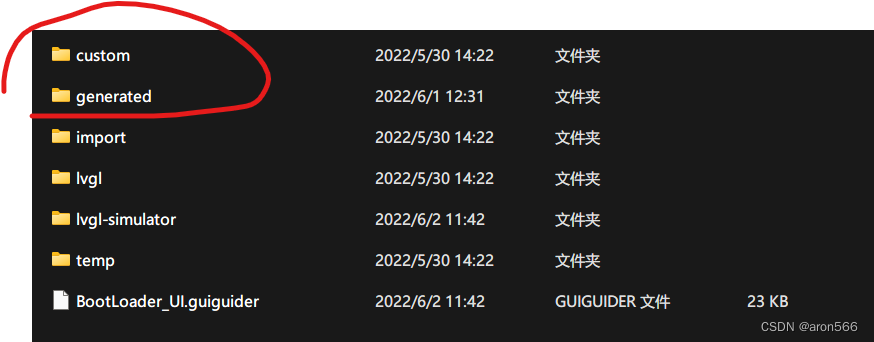
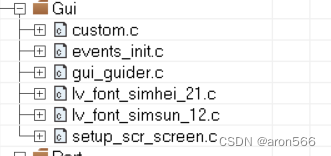
修改分散加载文件
用于将LCD显存指定到特定区域:USE_LCD_DMA_BUF_SPACE1 USE_LCD_DMA_BUF_SPACE2
/*###ICF### Section handled by ICF editor, don't touch! ****/
/*-Editor annotation file-*/
/* IcfEditorFile="$TOOLKIT_DIR$\config\ide\IcfEditor\cortex_v1_0.xml" */
/*-Specials-*/
define symbol __ICFEDIT_intvec_start__ = 0x08000000;
/*define symbol __ICFEDIT_const_data_start__ = 0x08008000;*/
/*-Memory Regions-*/
define symbol __ICFEDIT_region_ROM_start__ = 0x08000000;
define symbol __ICFEDIT_region_ROM_end__ = 0x0003FFFF;
define symbol __ICFEDIT_region_RAM_start__ = 0x20000000;
define symbol __ICFEDIT_region_RAM_end__ = 0x2001FFFF;
define symbol __ICFEDIT_region_ITCMRAM_start__ = 0x00000000;
define symbol __ICFEDIT_region_ITCMRAM_end__ = 0x0000FFFF;
define symbol __ICFEDIT_region_DMA_RAM_start__ = 0x38000000;
define symbol __ICFEDIT_region_DMA_RAM_End__ = 0x38010000;
/*-Sizes-*/
define symbol __ICFEDIT_size_cstack__ = 0x0000A000;
define symbol __ICFEDIT_size_heap__ = 0x0000C000;
/**** End of ICF editor section. ###ICF###*/
define memory mem with size = 4G;
define region ROM_region = mem:[from __ICFEDIT_region_ROM_start__ to __ICFEDIT_region_ROM_end__];
define region RAM_region = mem:[from __ICFEDIT_region_RAM_start__ to __ICFEDIT_region_RAM_end__];
define region ITCMRAM_region = mem:[from __ICFEDIT_region_ITCMRAM_start__ to __ICFEDIT_region_ITCMRAM_end__];
define region DMA_RAM_region = mem:[from 0x38000000 size 64K];
define region DMA_RAM3_region = mem:[from 0x30000000 size 128K];
define region DMA_RAM4_region = mem:[from 0x30020000 size 128K];
define block CSTACK with alignment = 8, size = __ICFEDIT_size_cstack__ { };
define block HEAP with alignment = 8, size = __ICFEDIT_size_heap__ { };
initialize by copy { readwrite };
do not initialize { section .noinit };
place at address mem:__ICFEDIT_intvec_start__ { readonly section .intvec };
/* place at address mem:__ICFEDIT_const_data_start__ { readonly section shellCommand };*/
place in ROM_region { readonly };
place in RAM_region { readwrite,
block CSTACK, block HEAP };
place in DMA_RAM_region { readwrite section USE_DMA_BUF_SPACE};
place in DMA_RAM3_region { readwrite section USE_LCD_DMA_BUF_SPACE1};
place in DMA_RAM4_region { readwrite section USE_LCD_DMA_BUF_SPACE2};
define exported symbol DMA_Buf_Addr_Startx = __ICFEDIT_region_DMA_RAM_start__;
define exported symbol DMA_Buf_Addr_Endx = __ICFEDIT_region_DMA_RAM_End__;
IAR中对齐访问问题
参考博客:https://blog.csdn.net/weekman93/article/details/124215098
1、代码中显存设置单字节对齐
#if defined(__ICCARM__) || defined(__ICCRX__)/**< IAR方式 */
#pragma pack(1) /**< 单字节对齐 */
#endif
/* 图形缓冲区 */
static lv_color_t buf2_1[LCD_FRAMEBUF_SIZE] MATH_PORT_SECTION("USE_LCD_DMA_BUF_SPACE1");
static lv_color_t buf2_2[LCD_FRAMEBUF_SIZE] MATH_PORT_SECTION("USE_LCD_DMA_BUF_SPACE2");
#if defined(__ICCARM__) || defined(__ICCRX__)/**< IAR方式 */
#pragma pack() /**< 恢复默认对齐方式 */
#endif
2、编译选项增加如下:使能非对齐访问
--no_unaligned_access
